Roller racing was extremely popular and in use as a form of public entertainment. As a club the Addiscombe had members in excellent form. Contests running for a whole week were frequently held at cinemas as an interlude between films or one-off contests took place at a company’s sports club. In the late 1940’s and early 1950’s Don Hunnisett, Eddie Roberts, Don Parris and Chris Brooker travelled by invitation as far afield as Ipswich, Birmingham and Kidderminster bringing home “trophies” in the form of cutlery, glassware, clocks and even hearthrugs! Nearer home they were joined by Norman Cox, Ray and Pat Cooke, Anne Hunnisett, Ron Pitt et al. A film company visited the clubroom in December 1948 and filmed the ladies roller racing. This short film was later shown in cinemas, including The Granada at Thornton Heath.
On 1st January 1949 Don Hunnisett and Chris Brooker were selected to represent the Southern Counties at the London Roller Championships, held in conjunction with a dance at Seymour Hall, London. There was great delight when they pulled off a double by winning their respective races. Norman Cox, Don Hunnisett, Eddie Roberts, Ray Cooke and Ron Pitt were invited to Wardour Studios to perform on Rollers for the production of a Technicolor film, which also appeared as a short film shown between the main films round the cinemas. By the mid 1950’s it was Daphne Grist and Ron Pitt and Peter White who were keeping up the tradition.
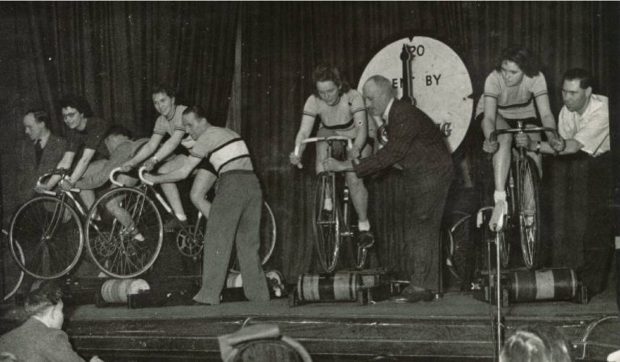
Following its make-over for the 1948 Olympics Herne Hill track was in regular use. The Club maintained the hire of a lock-up cabin under the stands. This was useful for changing, equipment storage and quite often a massage from Len Muller. Anne Hunnisett had been making excellent progress as a sprinter and with support from the Club’s racing fund was sent in 1948 to Manchester where she won the Ladies’ National Sprint title on Fallowfield track.
Referring to Anne’s Championship win, brother Don reported in The Gazette “We left London at noon on the Friday… …managed to squeeze onto the crowded train, obtain seats and settled down to a pile of books and papers. The further we went on our long journey, the worse the weather became…” Don was staying with Alan Bannister and Anne with Bannister’s fiancé. Don and Alan visited the track. “I was most disappointed with what I saw. The bankings were lower than Herne Hill, the track itself was narrower and the grass in the centre about six inches high. The surface was made of shale, which looked very similar to a newly gravelled road. Added to that it was beginning to rain and never before had I realised what a wonderful place Herne Hill was.” Of Anne’s event Don continues “There was a bad patch near the edge of the track the rest being loose as Anne found in the first heat of the Championship. Anne was forced out on to the loose and could only manage second place, but using her head well and selecting her position she won the repechage and the semi-final. In the final she sat in second place and kicked by in the straight to go on and win by three lengths.” Don competed in the men’s Handicap and Five miles events.
Although track events for women were very limited Anne Hunnisett continued to excel at both sprinting, particularly at Monday Competition meetings, and on the rollers. For the next three years the Ladies’ National Sprint Championship was run off at Coventry. In 1949 Hunnisett was unable to retain her title only managing bronze position. In 1950 she came away with the silver medal but although she had the full support of the club she failed to make the medal tables again and in 1953 rheumatic fever shortened her racing career. She put her name on the NCU record books at Herne Hill in 1948 when she broke the 440 yards standing start National bicycle record in 34.4/5th and with Daisy Stockwell, Apollo CC, the 440 yards flying start tandem record in 26.3/5. In 1951 she and Stockwell gained one more National record, the 880 yards unpaced flying start.
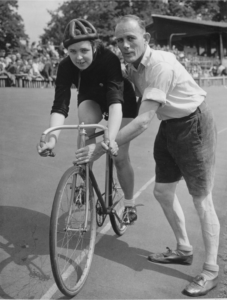
in the Ladies l lap Open Handicap four of the fourteen competitors were Addiscombe girls. With some of Britain’s male Olympic riders participating at the meeting, a BBC TV crew was on standby to televise their final. As it transpired the meeting ran late and to fit into the TV programme that was going out live the final of the ladies handicap race was shown instead with Chris Brooker only just pipping Pat Cooke to the line. This was in the days when few owned a TV set!
Anne’s success inspired other members to try the track despite the fact that apart from the Monday Competition promoters often had to be cajoled into putting on events for the ladies. It was for this reason the Women’s Track Racing Association was formed in 1949 with considerable input from our girls. The Association quickly got its own programme of events going and 1951 saw Anne win the WTRA Sprint Championship. As well as Anne, diminutive Pat Cooke scored numerous placings, excitedly cheered on by three young sons in the stands. Betty Flanagan and Brenda Tarrant were also early track girls followed by Maureen Cox, Chris Brooker, Sonia Bysh Nora Dexter, Eileen Newman, Eileen Cullen and Daphne Grist. At the NCU’s “Meeting of Champions” in
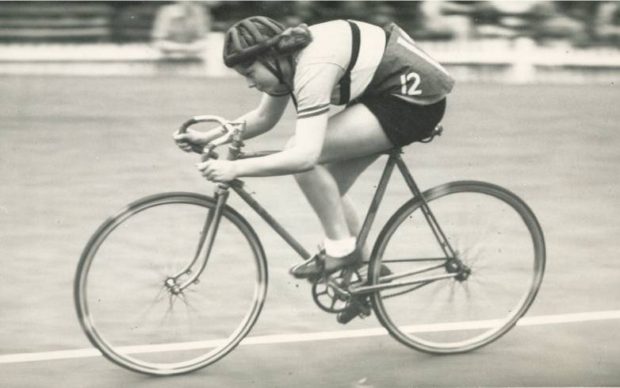
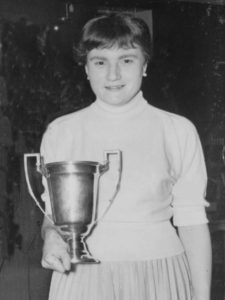
A strong rider, 22 year old Eileen Newman (pictured) took on the mantle of Ladies’ National Sprint Champion at Salford Park, Birmingham in 1952, four years after Anne Hunnisett had won the title. Like Hunnisett she was unable to repeat her win but settled for bronze position in 1954. Newman was regularly placed in the numerous track events she rode throughout the 1950’s, particularly in the Monday Competition series. Chris Brooker, Eileen Newman and Betty Perry took bronze medal position in the Ladies’ National Individual Pursuit Championships of 1951, 1953 and 1954 respectively. In an NCU Rally held in Battersea Park, Newman finished third in a roller racing competition and John Clarke was placed third in a 660 yards relay race.
For nine years the Addiscombe promoted an evening track meeting at the Hill. Torrential rain preceded the 1956, and last, meeting and left the running track resembling a canal. A successful attack on the NCU Women’s Tandem Hour Record by Chris and Daphne (pictured) resulted in their establishing figures of 25 miles 1229 yards for the Hour, 22 mins. 56 secs. for 10 miles and 58 mins. 22 secs. for 25 miles only to see these beaten one month later.
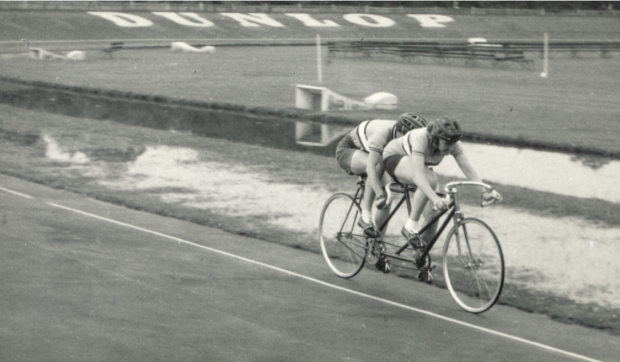
Of the club’s trackmen, by 1947 there was much spirited competition. Norman Cox and Don Hunnisett were our leading contenders with Bob Eatwell, Ray Cooke, Alan Stuart, Arthur Morbin, Tommy Ginn and Ernie Mills all riding well on grass or hard track. Wins and placings were not uncommon, as were crashes, and strong teams were put together for team pursuits, tandem races and madisons, Norman Cox winning the Medal Competition at the NCU’s Meeting of Champions.
The post-war club track vests were golden yellow with two black hoops on a white band. Most of the Davey frames ridden by members in the late 40’s and 50’s were also in club colours, i.e. gold finish and white seat panel edged with black bands. The NCU ruled on the compulsory use of crash helmets during racing and training on hard tracks in 1948.
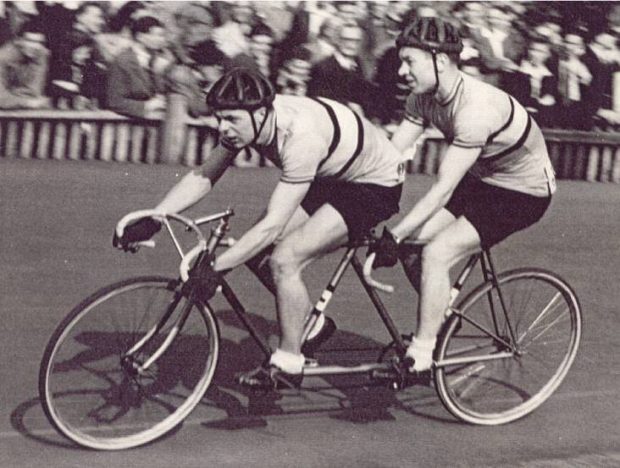
Third party insurance cover was a requirement of the club’s membership and at this period records show one hundred and twenty three members affiliated to the NCU. It is also reported that seventy-two members attended the Wembley Six-Day race. The ride (race?) home, by bike of course, in the early hours of the morning could be almost as exciting as the Six itself! Traffic was fortunately minimal.
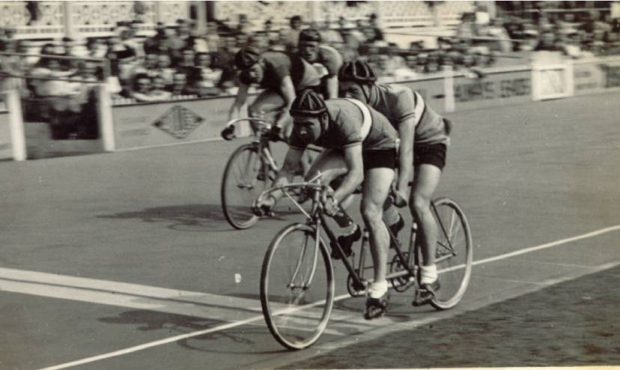
Don Hunnisett, partnered by Ernie Mills in 1948, achieved a brilliant 2nd place in the National Tandem Championship behind the Manchester pair of Reg Harris & Alan Bannister. Ranked as outsiders, Mills and Hunnisett had caused a major upset when they knocked out joint favourites Cox and Dennis in the second round and then Jefferies and Hampshire (pictured) in the Semi-Final.
The NCU Surrey Centre had been revived with Ernie Mills in the chair and local championships were organised. Don Hunnisett took the 1949 1,000 metres Championship.
The track season of 1950 had started with Don Hunnisett receiving an invitation to ride at the Good Friday Meet. His first claim move later in the season to the Polytechnic CC was a disappointment for the club. Norman Cox and his father restored the track cabin at Herne Hill and attempted to make it more secure as burglaries were not uncommon.
A series of inter-club grass track meetings was held at the White Nobbs Sports Ground, Caterham. Ron Pitt, Ray and Pat Cooke all excelled on grass and with good support from other members numerous awards were achieved. In 1951 Gus Luthwaite won the Dunlop Novices Cup at the Polytechnic meeting and took the club’s sprint and 5 miles championships. He was joined on the track by the likes of Harvey Smith, Don Parrish and John Miles.
1952 saw Alan Stuart, Ron Pitt, Mick Blake and Cyril Hinton reached the Surrey Centre 4,000 metres final. Although they lost to the Kingston R.C. they set a new club record of 5 mins. 12 secs.
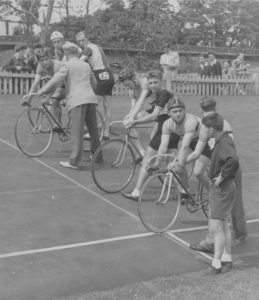
It was during a Madison Pursuit at the Hill that Alan Stuart when coming into the last lap, in real Six-Day style slung partner Ron Pitt into the field – minus a large section of his shorts! History records that Ron finished undaunted and the commentator reported Ron ‘split’ as second. Like many of the lads, Ron had to report for National Service but duty in Egypt allowed him to continue his cycling. The person who officially started many Herne Hill races during this period was Len Muller, fondly remembered as the man in the white coat with a starting pistol in his hand. A clubman since pre-war days Len was a good track secretary, promoter and masseur before he finally left the club to move up country.
Eileen Newman and Peter White were our main competitors in 1952 with Eileen achieving numerous wins and placings. White reached the quarterfinals of the 4,000 metres Individual Pursuit before being eliminated by the eventual winner Ken Mitchell, Willesden C.C.
The following year saw plenty of activity with members again scoring well in Monday Competition events at the Hill. The eventual winners eliminated Peter White and Mick Blake in the quarterfinals of the National Tandem Championship and an unspecified transport delay meant our pursuit team’s opponents were given a ride-over in the West London C.A. Championship.
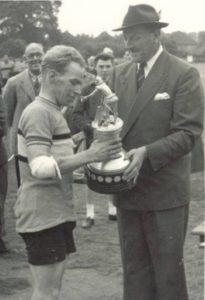
A highlight of 1954 was John Smith’s tandem-paced “12 Hours Marathon race” at Herne Hill on Saturday, 10th July. Raleigh Industries had a new perpetual trophy made with the idea of reviving past glories of long distance track races. Of the nine entrants only five finished and none were able to match Smith’s winning ride confirmed by the NCU as 303 miles 1221 yards. The rules permitted a limit of four tandems per rider but Smith started with just two, Cyril Hinton and Ron Drake, and Claud Perry partnered by Dave Wellman (Tottenham Phoenix). The 5 a.m. start meant club members working in shifts to look after the needs of their rider, with, for example, Ernie Mills coming straight off night work to relieve others who had to go to work. Despite a fine effort Perry and Wellman were not “knitting well” and early on a reluctant Alan Drury was coerced into taking over from Wellman “for a spell” that ended up lasting the rest of the day. Fellow competitor Brian Hawkes riding for R.E.M.E. C.C. only had one pacing tandem and when Hawkes was forced to retire from the race the Medway Wheelers pair generously added their support to Smith.
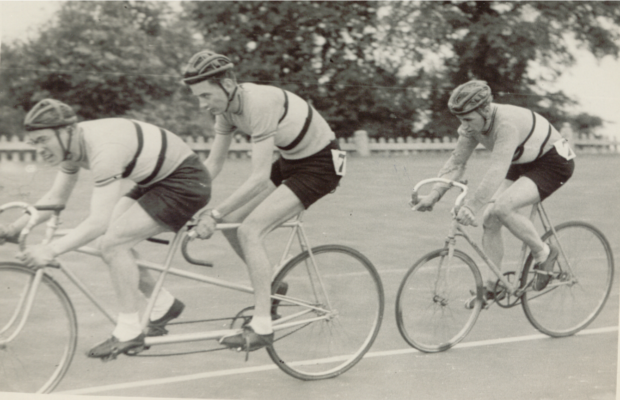
Peter White took over the track secretary’s duties from Len Muller at the beginning of 1956. Daphne Grist, Jean Burgess and Dave Olliffe scored well in Monday Competition races with Olliffe finishing the season 4th highest in the Points Competition. In the London Centre Pursuit Championship Daphne Grist got through to the final round only to be defeated by Daisy Franks.
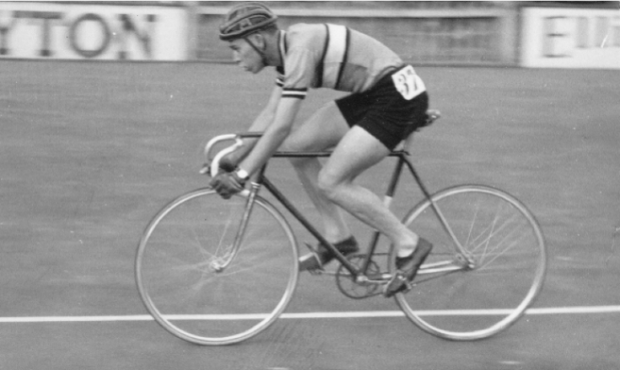
By the end of the season new member Ken Tuffnell, with Peter Moughton, Robin Kingsland, Peter White and Dave Olliffe were showing great promise and the latter four broke the club record for the 4,000 metres team pursuit with a ride of 5 mins. 9 secs.
- An Introduction to our History
- The 1883 Addiscombe Cycling Club
- The 1906 Addiscombe Cycling Club
- An Historical Background to the Road Record Associations
- A Brief Historical Background to Cycling Time Trials
- The Club’s Revival, 1929 to 1939
- The Club in Wartime, 1940 to 1946
- The Post-War Years, 1947 to 1957
- Post-War Track and Roller Racing
- The Men in Post-War Time Trials
- The Women in Post-War Time Trials
- Post-War Closed Circuit and Road Racing
- An Influx of New Riders and the Passing of a Statesman, 1958 to 1964
- The Club Heads Towards its Golden Jubilee, 1965 to 1978
- Membership Declines, 1979 to 1987
- The Arrival of the Young Mountain Bikers, 1988 to 1994
- Another Period of Declining Membership, 1995 to 1999
- New Century and a New Look for the Addiscombe, 2000 to 2006





